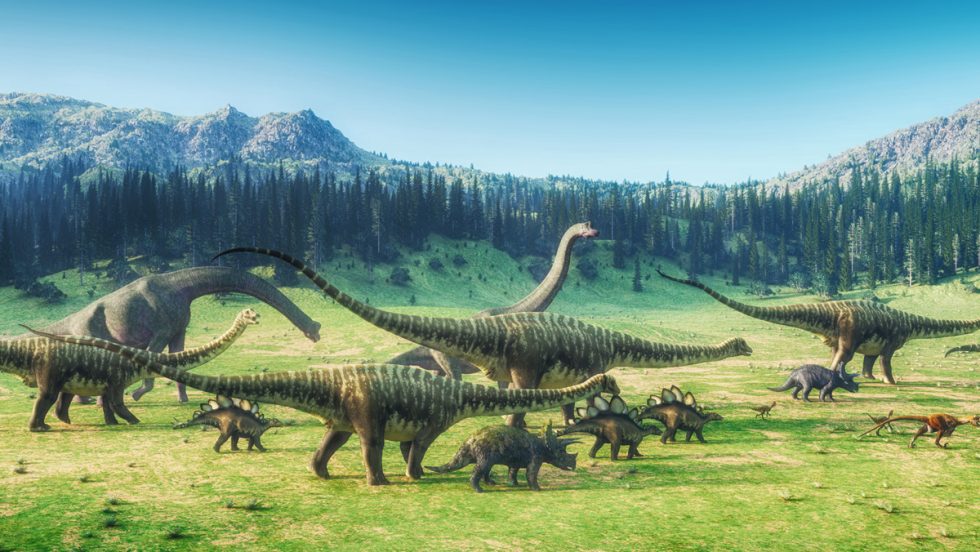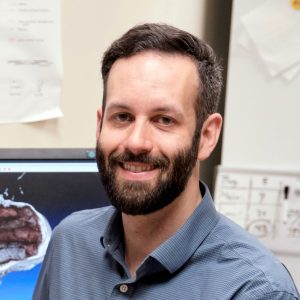
The latest research on how sauropod dinosaurs reached their massive sizes, authored by Michael D’Emic, PhD, associate professor of biology, has overturned decades of thinking on the topic. His groundbreaking research has been covered globally and will appear in Scientific American in September.

Michael D’Emic, PhD, Associate Professor of Biology
Michael D’Emic, PhD, associate professor of biology at Adelphi, has upended decades of conventional wisdom about how dinosaurs evolved to be giants.
For years, scientists believed dinosaurs reached their large body sizes via speedy growth spurts. Dr. D’Emic discovered that dinosaurs grew at a variety of rates, and that getting massive quickly wasn’t the only strategy for evolution. Some gigantic dinosaurs grew slowly, taking decades to reach full size. In fact, some smaller dinos grew in size quickly.
Dr. D’Emic’s findings, which were published in the journal Science in February 2023 and will be the subject of an article in Scientific American this fall, are only his latest to have a major impact on his field. He has produced evidence suggesting that dinosaurs were warm-blooded and that carnivorous dinosaurs could replace their teeth as fast as sharks. He also rewrote the evolutionary record by showing that flowering trees appeared in North America 15 million years earlier than previously thought.
Dr. D’Emic is one of a number of Adelphi researchers making significant contributions to scholarship in the study of ancient life. Bryan Wygal, PhD, professor and chair of anthropology, and Kathryn Krasinski, PhD, assistant professor of anthropology, have unearthed specimens in Alaska that shed light on the environment and its effect on patterns of human migration and subsistence in the late Pleistocene era. Anagnostis Agelarakis, PhD, professor of history, has produced fascinating finds on the island of Thasos that have illuminated the history of the ancient Greeks.
Finding the Keys to Dinosaur Growth
To determine dinosaur growth rates, Dr. D’Emic studied the bones of about three dozen species of dinosaurs in the theropod group, which includes two-legged carnivores like Tyrannosaurus rex and Velociraptor. Specifically, he looked at the growth rings in the dino bones. Yes, dinosaur bones have growth rings similar to trees that show how fast the creatures grew each year of their lives.
Dr. D’Emic affixed slices of dinosaur leg bones to glass slides, sanded them down to the thickness of a human hair so light could shine through them, then counted and measured the rings.
The results were surprising.
“Our study showed there’s no one way to grow a dinosaur,” he said. “The largest dinosaurs sometimes reached their adult size in just 10 years and some others took decades. There were vastly different growth rates in dinosaurs.
“Getting bigger faster wasn’t always a better evolutionary survival strategy,” Dr. D’Emic found. “Our study shows it’s just as likely they slowed their growth and grew for longer,” he said.
Bigger Isn’t Always Better
Dr. D’Emic found there were advantages and disadvantages to being a dinosaur that evolved to grow big, quickly. “Evolving to grow faster than your ancestors meant you could possibly outcompete other species in your environment for resources,” Dr. D’Emic said. “You could outpace the growth of your predators. You’re not small for as long, so maybe you’re not potential dinner for as long.”
But animals that grew fast didn’t always come out on top of the evolution game. “The disadvantage to evolving to grow fast is it takes a lot of energy,” Dr. D’Emic said. “If lean times come, like a drought, and there’s not much food around, you might be more prone to extinction. Sometimes slow and steady growth gives an advantage.”
A Decade of Research
Dr. D’Emic’s dinosaur bone study has been an epic project, which he conducted with an international group of colleagues from across the United States and in Argentina. He started looking at dinosaur bone growth rings in 2012. It took his team nine years to crunch all the data and reach his conclusions. They wrote up the results and submitted them for peer review, which took seven months.
The paper he and his team wrote on his research is titled “Developmental Strategies Underlying Gigantism and Miniaturization in Non-Avialan Theropod Dinosaurs.” Three of his Adelphi graduate students—Riley Sombathy, MS ’21, Anjali Dave ’17, DDS, and Thomas Pascucci, MS ’19—co-wrote the research paper, which makes Dr. D’Emic a proud professor. “They used that research as their capstone projects. For two, it was their master’s thesis that got folded into our paper.”
At Adelphi, Dr. D’Emic teaches biology classes, including anatomy and physiology. He also teaches a class on evolution for graduate students and senior undergraduates. In the summers, he puts on his fieldwork hat and takes students out on digs in Wyoming or Utah. “We find crocodile, turtle and mammal fossils as well as dinosaur ones,” he said. “We found baby dinosaurs one summer and that was really interesting. One was only four or five years old. It was like a teenager, gangly with long legs.”
Dinos Grew Much Like Animals Today
His research into the variety of dinosaur growth rates connects them to animals still alive today, who also grow at different rates. “We show that (dinosaurs) are just like animals today, in that they lived in an ecosystem that impacted how they grew and evolved. It’s really interesting to see the parallels between past and present.”
For his next project, he’d like to determine the environmental factors affecting the dinosaur growth rates he sees in those bone growth rings. Did climate affect growth rates? Competitors? He’ll need to match the bones against ancient climate patterns and he’ll need to collect a lot more dinosaur bone samples.
Since it took him a decade to locate and examine the dinosaur bone samples he used in the growth research, he plans to look at mammal and bird bones to figure out what factors influence evolutionary growth rates. “Mammals and birds have a much, much better fossil record,” he said. “You can do the study in about a 10th of the time because there’s more data and there’s more fossils.” He’s already been collecting mammal and bird fossils with an eye to this future research. Dr. D’Emic said he can find them near his dig site in Wyoming, in a different rock layer than the one where he usually digs for dinosaurs.
“It’s only a half hour drive from where I usually dig, so I started a new project a couple of years ago,” he said. “We’re already investigating.”